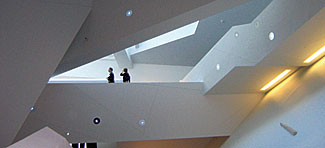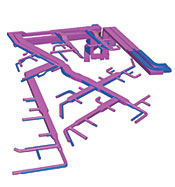Integrated BIM and Design Review for Safer, Better Buildings
Constructability and Coordination
Another place demanding safety is the construction site itself, where the coordination and completeness of the integrated BIM data helps ensure proper scheduling and staging of construction tasks. Some general contractors and construction managers (CMs) also use BIM to reduce the amount of waste on site-an important part of sustainable construction practice-as well as loose material that can be a theft target. Additional uses include facilitating movement on the site and reducing the number of workers needed: the bottom line, fewer human and material resources to complete the tasks at hand.
Less activity on the job site also contributes to a safer construction process, as well as a better liability picture, say some. "The more the team understands what's going on, the liability issues tend to be reduced," says Dan Gonzales, corporate manager of Virtual Design and Construction at Swinerton Construction. "In a paper-based, 2-D environment, everyone only understands their piece; but with 3-D, everyone is looking at the same model. And the design-review tool reads so many different models that everyone still has responsibility for their own model, so there is no change in liabilities," he says. "From that standpoint, I think design review keeps liabilities clear."
According to The Contractor's Guide to BIM, published by Associated General Contractors (AGC), the advantages of using BIM include: identifying collisions, such as where piping may run into structural steel; studying what will be built in a safe, simulated environment; reducing errors and corrections in the field; having more reliable expectations of field conditions; being able to incorporate more prefabricated components and assemblies; and comparing of "what if" scenarios for logistics, sequencing, hoisting and other major moves. The AGC also writes that BIM can reduce callbacks and warranty costs.
With its early design review, the BIM process essentially shifts project coordination to much earlier in cycle, says Boryslawski. "The numbers of trades working in a tight area is minimized, and some parts of MEP are assembled off site from the BIM 3-D shop models, also contributing to safety due to fewer people on site during the installation process," he explains. "And the trades have a clear understanding as to the position of all the items within the confined space."
Swinerton, for one, reports frequent uses of the BIM model in the field. "We use BIM to plan equipment placement, storage, and on-site conditions, and to tie into our sequencing to really look at how a building is going to built," says Gonzales. "For example, we use BIM to make sure lower areas are cleared away when you're placing steel."
Risk Reduction
With such significant health and safety benefits in both design and construction phases, it follows that overall project liability, as well as project team risk, can be reduced, too. Issues of design coordination, conflicts, and code compliance can be addressed during design, rather than construction. Projects should have less variability in cost and construction time, along with fewer claims.
"Architects, as well as their consultants, working with a building information model, reduce risk because the model makes the relation of design information explicit within the same virtual space," says Jogan. "The ambiguity between the architect's design intent and the ‘fit' of a consultant's building system is practically eliminated."
|
During the development of the project, strict rules can be applied to police the model, restricting access rights and allowing changes only by authorized project team members, according to Lachmi Khemlani, editor of AECbytes. When versions of the model fall out of date, they can be automatically destroyed or archived, with a precise audit trail. Responsibility for the various models can also be clearly assigned. "For instance, quantity take-offs is not something that the design team should be responsible for any more in 3-D than in 2-D, even though the model itself can generate this," Lowe explains. "Shop drawings, as well, remain on the contractor side."
In some recent cases, the BIM model has remained contractually subordinate to 2-D documents, as was the case for work on the Denver Art Museum. In the future, more design teams will rely more on electronic data so that construction pricing, scheduling and detailing can be generated without duplicating 2-D documents. One of the reasons is that BIM tools are becoming available for more construction specialties and vendors. For the Denver museum, according to Engineering News-Record, the model specifically designed for steel fabrication was used to procure other building systems.












